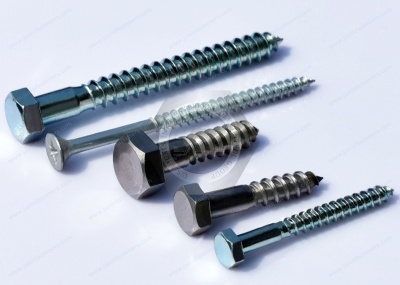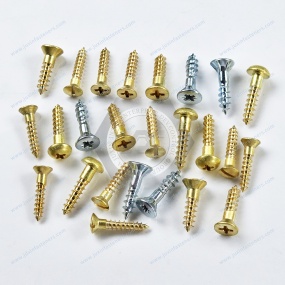Call Us
+86 136 6007 9809
Call Us
+86 136 6007 9809
Oct. 23, 2024
Steel Phillips Flat Head Screws for Wood, These screws are beveled under the head for use in countersunk holes. They press threads into material for a tight, secure hold. To prevent splitting, drill a pilot hole slightly smaller than the screw.
In the construction industry, wood screws are used to connect metal to other materials and wood products, providing stable connections and fastening force. Typical applications include furniture manufacturing, such as cabinets, chairs, tables, beds, and almost any type of furniture. Wood screws need to be used with other furniture fasteners, such as cross screws, insert nuts, or their matching furniture connection caps.
There are many types of wood screws, including flat head type, oval head type, etc., and the materials include stainless steel, carbon steel, brass, etc.
Steel Phillips Flat Head Screws for Wood
18-8 Stainless Steel Phillips Flat Head Screws for Wood
Super-Corrosion-Resistant 316 Stainless Steel Phillips Flat Head Screws for Wood
Brass Phillips Flat Head Screws for Wood
Steel Square-Drive Flat Head Screws for Wood
Brass Square-Drive Flat-Head Screws for Wood
Torx Flat Head Screws for Wood
Brass Slotted Flat Head Screws for Wood
Steel Slotted Flat Head Screws for Wood
Stainless Steel Slotted Flat Head Screws for Wood
Stainless Steel Slotted Oval Head Screws for Wood
Brass Slotted Oval Head Screws for Wood
Phillips Oval Head Screws for Wood
Steel Hex Head Screws for Wood
Metric Steel Hex Head Screws for Wood
18-8 Stainless Steel Hex Head Screws for Wood
Super-Corrosion-Resistant 316 Stainless Steel Hex Head Screws for Wood
Phillips Decorative Rounded Head Screws for Wood
Brass Slotted Decorative Rounded Head Screws for Wood
Steel Slotted Decorative Rounded Head Screws for Wood
Stainless Steel Slotted Decorative Rounded Head Screws for Wood
Flanged Rounded Head Screws for Wood
Steel Flanged Hex Head Screws for Wood
Stainless Steel Flanged Hex Head Screws for Wood
Steel Phillips Drilling Screws for Joining Wood to Metal
Stainless Steel Phillips Drilling Screws for Joining Wood to Metal
Torx Drilling Screws for Joining Wood to Metal
Thread-Forming Screws for Joining Wood to Metal
Screws for Hardwood
Steel Rounded Head Screws for Plywood and Oriented Strand Board
Stainless Steel Rounded Head Screws for Plywood and Oriented Strand Board
Steel Flat Head Screws for Plywood and Oriented Strand Board
Super-Corrosion-Resistant 316 Stainless Steel Flat
Head Screws for Plywood and Oriented Strand Board
Rounded Head Screws for Particleboard and Fiberboard
18-8 Stainless Steel Flat Head Screws for Plywood and Oriented Strand Board
Flat Head Screws for Particleboard and Fiberboard
18-8 Stainless Steel Square-Drive Screws for Softwood and Plastic-Wood Composites
Super-Corrosion-Resistant 316 Stainless Steel Square-Drive
Screws for Softwood and Plastic-Wood Composites
Phillips Screws for Softwood and Plastic-Wood Composites
Steel Thread-Cutting Small-Head Screws for Softwood and Plastic-Wood Composites
18-8 Stainless Steel Thread-Cutting Small-Head Screws for Softwood and Plastic-Wood Composites
Super-Corrosion-Resistant 316 Stainless Steel Thread-Cutting Small-Head Screws for Softwood and Plastic-Wood Composites
Thread-Forming Small-Head Screws for Softwood and Plastic-Wood Composites
Distortion-Free Screws for Plastic-Wood Composites
Sealing Screws for Softwood and Plastic-Wood Composites


As fasteners, screws are widely used in various machinery, equipment, and products. If there are quality problems with screws, such as dimensional deviation, insufficient strength, or material defects, it may lead to equipment failure, product performance degradation, and even safety accidents. Therefore, strict inspection of screws is a crucial link to ensure product quality and safety, and preventing potential risks is another vital aspect of screw inspection. Through inspection, potential quality problems can be discovered, and timely measures can be taken to improve and prevent them, reducing the risks caused by screw quality problems.
Dimension inspection is the process of inspecting the size and tolerance of screws. The size of screws includes diameter, length, thread depth, and tolerance. By measuring these dimensions, it can be ensured that the screws meet the design requirements and standard specifications. Commonly used inspection methods include measuring tools such as calipers and micrometers.
1. Ensure the inspection process is accurate, reliable, and compliant with relevant standards and specifications.
2. Select inspection methods and techniques to improve inspection efficiency and accuracy.
3. Pay attention to data analysis and recording to provide a basis for subsequent production and improvement.
4. Establish a complete inspection system to ensure each link is effectively controlled and managed.
Email:adelajonly@gmail.com
Website:www.juxinfasteners.com
WhatsApp:+86 13660079809
Contact Us
Tel.:
+86 020 8621 0320
+86 020 3121 6067
Technical Support:
Navigation
SEND INQUIREY